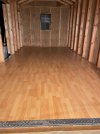So I am considering insulating my shop. It is one of those prefab 10x20 buildings, and there is currently no insulation.

I have 2 Oil Radiator heaters (not sure if that is there official name) for heat in the winter and a small window AC unit for the summer. The heaters do a very good job but the AC not so much. I plan to install some bigger vents in the top of the gables - right now they look to be about 6x12. I may even try an exhaust fan that cuts on at a certain temp, but I am getting ahead of my budget - LOL.
I ran across a business selling some of the 2" Rigid Insulation, the yellow foam with the black paper-ish on both sides. I believe this to be polyisocyanurate or polyiso. He said it was what they put on flat roofs before covering it with vinyl.
He is only asking $8 for a 4x8 sheet and I would need 25 sheets. So that means I could insulate my shop for $200 plus my labor and misc h.
So my questions are:
1. Is this stuff safe to use inside?
2. I am planning to put the insulation at the very top between the joists just below the roof sheathing. I read a lot about needing an air gap to prevent condensation.
a. How much of a gap is needed?
b. Do I need plastic or something between the insulation and the sheathing?
3. Can I glue this to the exterior walls? I do not plan to cover the walls with sheetrock or anything (trying to keep the cost down) and I thought this would be a good way to keep it in place.
Thanks in advance for your constructive input.

I have 2 Oil Radiator heaters (not sure if that is there official name) for heat in the winter and a small window AC unit for the summer. The heaters do a very good job but the AC not so much. I plan to install some bigger vents in the top of the gables - right now they look to be about 6x12. I may even try an exhaust fan that cuts on at a certain temp, but I am getting ahead of my budget - LOL.
I ran across a business selling some of the 2" Rigid Insulation, the yellow foam with the black paper-ish on both sides. I believe this to be polyisocyanurate or polyiso. He said it was what they put on flat roofs before covering it with vinyl.
He is only asking $8 for a 4x8 sheet and I would need 25 sheets. So that means I could insulate my shop for $200 plus my labor and misc h.
So my questions are:
1. Is this stuff safe to use inside?
2. I am planning to put the insulation at the very top between the joists just below the roof sheathing. I read a lot about needing an air gap to prevent condensation.
a. How much of a gap is needed?
b. Do I need plastic or something between the insulation and the sheathing?
3. Can I glue this to the exterior walls? I do not plan to cover the walls with sheetrock or anything (trying to keep the cost down) and I thought this would be a good way to keep it in place.
Thanks in advance for your constructive input.
